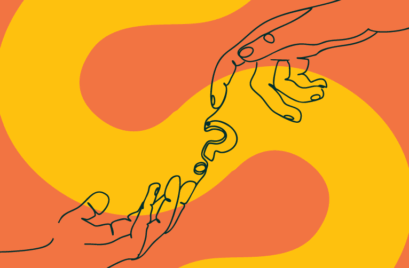
“The organisation modelled on living systems is a move away from thinking of the organisation as a rigid, reductive, mechanistic hierarchy, living systems are agile, vibrant, resilient, responsive, innovative, diverse and regenerative.” Giles Hutchins and Laura Storm
In our previous works, we’ve examined the theory of regenerative leadership and the mindsets of regenerative leaders. In this piece, we are looking to the future and what leading “regenerative” thinking might look like as a long-term strategy
As we know, regenerative futures are not just about tackling climate change – although that is of course a pressing issue. A regenerative future encompasses a number of dimensions of regenerative ways of being (people, places, traditions and the world) and how these ways coalesce and integrate over time.
In beginning to assume a more nuanced view of regeneration, we can see that these dimensions are profoundly interconnected. As Kate Raworth’s Doughnut Model of ecological boundaries demonstrates, our social dimensions impact significantly on our ecological relationship and vice versa.
At the core of regenerative thinking are two key elements:
- Unearthing the real needs of the system, and satisfying them, rather than creating false needs that encourage overconsumption
- Perceiving resources holistically, rather than for short-term gain (i.e. the social, environmental and economic value of goods and services is taken into account)
An important step for us in combating short-term bias and our interests in the here and now, is to start imagining what we want the world to look like. Take, for example, Regenerating Australia, which provides such a glimpse into the future. To lead regenerative futures we have to be able to envision, articulate, and communicate them.
So, let’s explore some regenerative futures from this greater perspective:
People
People are fundamental to regenerative ways of thinking and the workplace can have an outsized impact on people’s lives. Work commitments and environments are often credited as some of the greatest stressors people experience. Beyond this, work stress sits amongst an array of other stressors of modern life: social isolation, being always ‘on’ and juggling an overload of commitments.
Leading regeneratively asks us then: How do we regenerate our people rather than just sustain them? How do we heal, energise and uplift them? How can we support them to find their purpose and achieve it? And the answer comes down to one central idea: seeing your people as part of your organisation’s purpose. We want to see our organisation as partly serving its own people. What can it do to give them joy and meaning in their life? How can it elevate their life as well as achieve its other goals?
A major shift this demands of us is moving away from the mechanist organisational mode of hierarchies and bureaucracy based on power and control. These hierarchies operate to stifle our potential and capacity to thrive. Instead, the structures we want to build are those that give people the space to develop, learn, and grow in their own way. In such structures, people are better positioned to be empathic, trusting and practice high levels of relationality.
To develop this, there are a few things you can do according to Giles Hutchins and Laura Storm’s Regenerative Leadership:
- Embed regular processes for ongoing development like 360-feedback, peer to peer learning, coaching and check-ins
- Build a culture of authenticity, where people feel comfortable bringing their whole selves to work
- Demonstrate openness by sharing vulnerable stories and circulating lessons learnt as the norm for collective growth
- Make diversity a strategic priority by focusing on inclusion and celebrating differences
We want to work towards empowering people to make their own decisions on selected projects without needing to seek approval – testing out our self-organising ways of working. At a more structural level, we can connect the team to the organisational direction through employee representation in leadership. In Germany, for example, the principle of co-determination requires a percentage of worker representation on the supervisory board of organisations above a certain size. This ensures that team members’ voices feature as part of the organisation’s central identity.
Consider this for a regenerative future: sharing vulnerable stories with your team, celebrating diverse cultural events and festivals, developing employee councils, supporting purpose-led work, and implementing wellbeing initiatives and job crafting.
Place
Regenerative leadership speaks a lot to our relationship with place. We are in an era of human history where we often feel highly abstracted from our surroundings and disconnected from the land we live on. We spend lengthy periods inside and zeroed into screens, oblivious to the broader world.
Regenerating place means thinking deeply about your sense of place and imprint on the world and how you can be collaborative with (and part of) nature rather than disregarding it. It means learning the history of where we are and understanding better the surrounding environment. What is the native fauna or flora of this region? How has it developed over time? Appreciating, as we are biologically predisposed, the beauty of the world and spending time with it each day. We know that the greater our sense of place, the more we will become stewards of it.
In Regenerative Leadership, Hutchins and Storm suggest designing in ways that allow people to reconnect to nature within and around them. The science is becoming increasingly clear that cultivating this relationship relieves stress, improves creativity, and enhances well-being. For example, you could implement this by hosting meetings in nature. Biophilic design can also be used to inform interior design through plenty of natural light, natural air flows, plants, and natural textures, colours, and patterns.
Consider this for a regenerative future: meeting in nature, re-greened office, and home spaces, encouraging local action and sharing histories of place.
Tradition
We also want to think about regenerating tradition. Tradition is a chain of human memory connecting us to our history, our culture and what is important around us. It is a rich source of knowledge, meaning and purpose in life. Again, modern life is often characterised by a forgetting of tradition in favour of the immediate pleasures and demands of technology and the attention economy.
Regenerating tradition means giving people the space to live and think in their traditions. It also means educating yourself and those around you about the traditions of your land and other people. Many, if not all, human traditions that existed before the industrial evolution were intrinsically regenerative (such as First Nations people). As Christopher Wahl puts it:
“In many ways, regenerative cultures isn’t something new — regenerative cultures is remembering the inheritance of our species’ long history. For 200,000 years, we have been bio-regionally adapted cultures that tried to manage or work with the ecosystems they inhabit.”
Research has shown that concentrating resources and energy on cultural restoration enhances social and economic development. We are also seeing the benefits when we welcome a broader view of the world beyond the calculus of technological-productive logics. We must tap into and renew our rich inheritance.
Australia is home to the world’s oldest, continuous living culture. For more than 65,000 years, Indigenous Australians have cared for this country, its land, and sea. Organisations must respect and understand this culture and engage in meaningful consultation and partnership with Indigenous peoples. For example, you could implement this by reintegrating indigenous culture through observing natural cycles and patterns. Importantly, you may take voluntary actions that promote and support Indigenous rights and demonstrate commitment to Reconciliation Action Plans.
Consider this for a regenerative future: paying attention to discourse and design informed by diverse cultural traditions, supporting Indigenous rights, and informing yourself about Indigenous wisdom.
The World (and not just the climate!)
Regeneration also speaks to the world beyond the climate crisis. We know, for example, that human impact on the world has reached critical levels in other dimensions. The Planetary Boundaries framework establishes nine boundaries that the Earth must be kept within to prevent significant harm to human systems. These are processes, which “regulate the stability and resilience of the Earth system”.
Scientists already consider us to have surpassed the safe operating space for a number of these boundaries, including the release of novel entities (such as chemical pollutants and plastics) and biogeochemical flows. Think about how your organisation could be impacting these other parts of the natural environment. For example, you might consider:
- How the products you produce or consume could become part of a circular closed economy, rather than a waste economy.
- Ways in which biomimicry or bio-inspired innovation can create products or services that are regenerative, non-toxic, biodegradable, and adaptive
- Building partnerships with organisations who share your values to work towards tackling planetary challenges
Consider this for a regenerative future: Design holistic action plans to return within the planetary boundaries such as circular economies, zero-waste, and resource replenishment
Future thinking means anticipating how these dimensions might evolve as well. Consider how your workforce is changing and the social changes that are occurring around them and through it. Think about how a place might be used in the emerging future. Think about how traditions are contextually dependent. Think about what the world could look like in the future with changing environmental conditions and technology.
And, most of all, think about where you want to be when this all happens, leading or following.
“Designing a way of living and leading flourishing lives based on principles conducive to life, is the key mission of our times” Giles Hutchins and Laura Storm
Need More Help?
Keen to find out more about how to lead regeneratively for people, place, tradition, and planet? Performance Frontiers help guide leaders to lean into abundant future thinking and to unearth the real needs of your organisation’s ecosystems. Speak to Lina today about how we can partner with you to envision, articulate, and communicate your best future.







